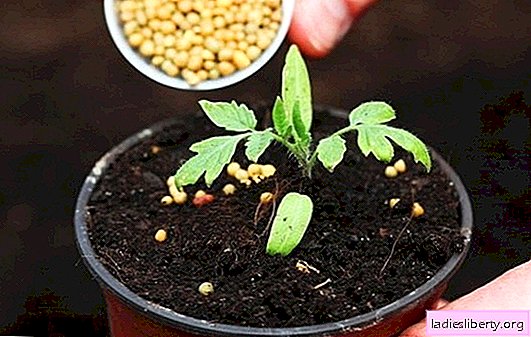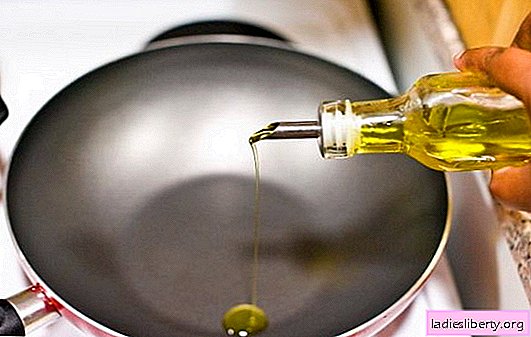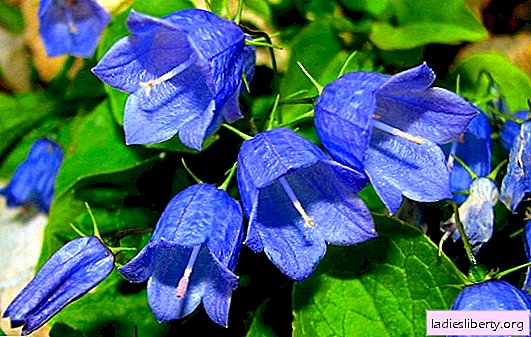
It's no secret that tomatoes are grown to produce delicious fruits.
But in order to obtain the required amount of harvest, first you need to prepare high-quality seedlings of tomatoes, during the cultivation of which you need to correctly apply various fertilizers.
Additional nutrients to this culture are needed almost constantly.
How to determine that tomato seedlings are lacking in nutrients?
Very often beginners, and experienced gardeners ask, "How to feed tomato seedlings so that there are plump and healthy shoots?" This is the right question - plants with thin stems cannot form a normal crop.
When growing seedlings, tomato seeds are sown in the soil with nutrients added in advance. For this reason, they begin to think about dressing after transplanting seedlings to a permanent place.
Attention! It is necessary to begin preparing the site for tomatoes in the fall, at which time it is fertilized with humus or manure, and phosphorus fertilizers are added. In areas with loamy and clayy soil, a small amount of rotted sawdust and peat is introduced in the autumn. A site with acidic soil needs to be liming; do not forget that in the spring you can only fertilize the beds with organic fertilizers with biohumus and good humus.

It is important to properly tomato tomatoes. But it’s not always that seedlings dived according to all the rules are developing well, its appearance will tell you what is necessary for plants:
• If the seedlings sharply slow down their growth after transplantation and the leaves brighten, then the plant lacks nitrogen;
• Seedlings, rapidly growing vegetative mass, need to reduce nitrogen fertilizing (this is called "fattening", it can cause poor fruit setting);
• Leaves with a purple hue, indicate a lack of phosphorus, if there is a lot of it - the ovaries and the leaves will begin to fall off;
• Fading seedlings after transplantation with sufficient watering require nitrogen top dressing;
• Curled foliage on seedlings indicates a lack of potassium and nitrogen, and too much phosphorus in the soil.
It is necessary to feed tomato seedlings if the beds are prepared on a site with sandy soil. When feeding seedlings, do not exceed the recommended dosage of fertilizers, seedlings are better to "underfeed" (a high content of mineral elements in the soil solution is very harmful to plants).
Topping tomato seedlings
No matter what fertilizer you feed tomatoes, in any case, you must follow the recommended dosage. The feeding pattern is almost unchanged:
1. On the 15th day after transplanting seedlings, containers with seedlings must be fed - 1 tsp is added per 1 liter of water. complex fertilizer for tomatoes and nitrofoski. This plant is watered with each plant 100 g each;
2. On the 25th day, you need to feed the plants with a solution of nitrophosphate (add 1 tsp of fertilizer to 1 liter of water). It does not hurt to add 0.5 tsp. complex fertilizer. This top dressing can be carried out 1 time in 10 days;
3. 10 days after transplanting the plants to a permanent place. It is watered with potassium permanganate;
4. 25 days after planting at a constant place, the plants are fed with potassium nitrate (dissolve 20 g of fertilizer in a bucket of water);
5. Foliar top dressing is very useful for seedlings, they accelerate the ripening of fruits. So you can feed seedlings 1 time in 6-7 days. 15 g of potassium sulfate, 10 g of double superphosphate and 15 g of urea are dissolved in a bucket of water;
6. When forming the first inflorescences, seedlings are fed a solution of azofoska and mullein;
7. Flowering plants need to be fed another 2-3 times, which are carried out after 2 weeks. 25 grams of chicken droppings and 25 grams of potassium sulfate are bred in a bucket of water. Instead of droppings, you can use potassium nitrate, 25 grams of substance are added to a bucket of water.
Please note! If you planted tomatoes on poor soil, in the rainy year you need to feed the plants 2 times more often. But the dose of fertilizers must be reduced by 1/3 so that it "does not burn out."
Fertilizers for tomatoes
There are many fertilizers, both organic and mineral, that are used for top dressing.
Mullein
It is often used for feeding tomatoes, but fresh it can be applied to the soil only in the autumn period. When feeding seedlings with mullein, they fill ½ bucket and fill it with water. In this form, the fertilizer is kept for several days in the sun. After the mullein ferments the solution, 1:10 is diluted and the tomato bushes are watered.

Attention! A large amount of mullein is harmful for tomatoes, a large concentration can destroy the bushes.
Wood ash
During transplanting, 1 tablespoon is introduced into the planting pits. ash, this will provide plants with the necessary trace elements for a long time. You can simply remove it from the stove after burning wood, or make a bonfire from branches, straw or leaves in the area where the tomatoes will grow.
Ash is good in that it contains many trace elements, calcium, phosphorus and enough potassium. Only you can’t add a lot of it - it’s better to feed the area with ash in the autumn period, you can’t add more than 0.5 kg per 1 m2.
Tomato Yeast
Not every gardener knows that yeast dressing has a good effect on tomato seedlings. To do this, 10 grams of live yeast are dissolved in a bucket of water. Yeast fermentation will be much better if heated water and a small amount of sugar are used for the solution. The solution is poured under tomato bushes.
Feeding with iodine
Such top dressing will increase the mass of fruits and slightly accelerate their ripening. Plants are watered once every 7 days with a solution of 1 bucket of water with 4-5 drops of iodine dissolved.
Urea Tomato Fertilizer
This substance is an excellent source of nitrogen. Plant nutrition begins after transplanting to a permanent place, the bushes are watered with an aqueous solution at the rate of 20 g of substance per 1 m2. But in order to avoid problems (overdose of this strong nitrogen fertilizer), urea is best used exclusively for foliar (spraying) feeding.
Did you know? During a dive, saltpeter and superphosphate can also be added to the wells in which seedlings will be planted. However, more than 1 tablespoon of fertilizer cannot be used per hole.
Technology of foliar plant nutrition
This treatment is carried out by spraying plants with an aqueous solution of low concentration fertilizer. This is an optional procedure, it is mainly used as an ambulance for plants (when spraying plants with fertilizers, they are very quickly absorbed by the leaves and immediately begin to act).

Most often, urea is used for such top dressing and Boron, which helps tomato bushes like this:
• Processing inflorescences with boron, stimulates fruit set and accelerates their development;
• Tomatoes after processing grow sweeter;
• This top dressing reduces the risk of plants becoming infected with diseases and pests.
Tomato bushes are treated with a composition prepared according to this recipe - 1 g of boric acid is dissolved in 1 liter of heated water. The solution is treated not only with the ovaries and leaves, but also with the formed fruits.











